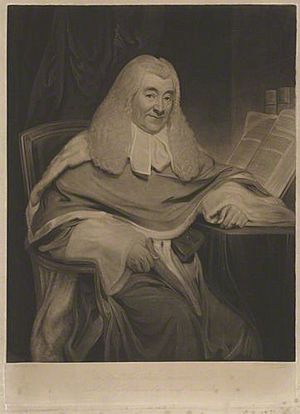Alan Chambré facts for kids
Quick facts for kids
Sir Alan Chambré
|
|
|---|---|

Sir Alan Chambré, mezzotint by Henry Meyer, after Sir William Allan
|
|
| court of common pleas | |
| Personal details | |
| Born | 4 October 1739 Kendal, Westmorland |
| Died | 20 September 1823 (aged 83) Harrogate |
Sir Alan Chambré (born October 4, 1739 – died September 20, 1823) was an important English judge. He spent many years working in the legal system, eventually becoming a judge in some of England's highest courts. He was known for his long and successful career in law.
Contents
Life of a Judge
Early Life and Education
Alan Chambré was born in Kendal, Westmorland, England, on October 4, 1739. He was the oldest son of Walter Chambré, who was also a lawyer. His mother was Mary Morland.
Young Alan first went to Kendal Grammar School. After that, he continued his studies at Sedbergh School. These schools helped him prepare for a future in law.
Becoming a Lawyer
After finishing school, Alan Chambré moved to London. He started working in a solicitor's office in Pall Mall. A solicitor helps people with legal matters.
He also joined a legal society called Staple Inn. Later, he moved to the Middle Temple in February 1758. Then, in November 1764, he joined Gray's Inn. These are all important places where lawyers train.
In May 1767, Alan Chambré officially became a barrister. A barrister is a lawyer who argues cases in court. He quickly became one of the top barristers on the northern circuit, which was a route judges and lawyers traveled to hear cases.
Rising to Judge
In 1796, Alan Chambré was chosen to be the recorder of Lancaster. A recorder is a judge who works part-time in a city.
When Judge Richard Perryn retired, Chambré was chosen to take his place. To become a judge, he first needed to become a "serjeant-at-law." This was a special rank for top barristers.
Normally, serjeants could only be appointed at certain times of the year. But Judge Perryn retired at an unusual time. So, a special law was passed in 1799 to allow Chambré to become a serjeant right away. This law was called the Courts of Exchequer Act 1799.
On July 2, 1799, Chambré became a serjeant. On the very same day, he was appointed a baron of the exchequer. This meant he became a judge in the Court of Exchequer, which handled financial cases.
Another law was passed later that year. This new law made it easier to appoint judges at any time.
Later Career and Retirement
On June 13, 1800, Chambré moved to a different court. He became a judge in the Court of Common Pleas. This court dealt with everyday legal disputes. He took over from Sir Francis Buller.
Sir Alan Chambré stayed in this court until December 1815. After more than fifteen years as a judge, he decided to retire. He received a pension of £2,000 a year, thanks to a law passed in 1799.
Sir Alan Chambré passed away in Harrogate on September 20, 1823. He was 83 years old. He was buried in his family's burial place at Kendal parish church. A monument was put up there to remember him. He never married.

